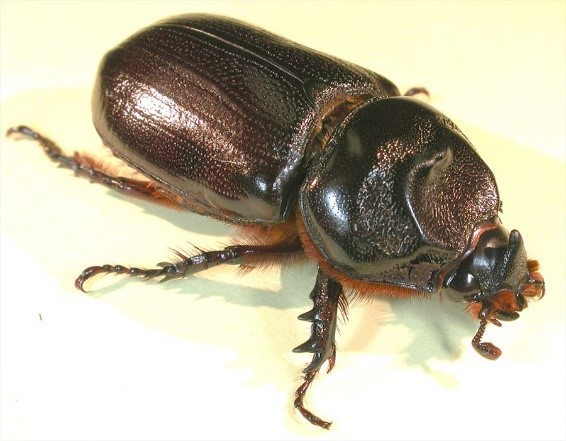
The enantiomers of ethyl 4-methyloctanoate and 4-methyloctanoic acid were conveniently prepared by enzymatic resolution of the commercially-available acid, and the enantiomers of the acid, but not the ester, could be separated by gas chromatography on an enantioselective cyclodextrin phase. Ethyl 4-methyloctanoate elicited a strong electroantennogram response from both male and female CRB-G, but these other compounds, including 4-methyloctanoic acid, did not. No other male-specific compounds could be detected, in particular methyl 4-methyloctanoate, 4-methyl-1-octanol, or 4-methyl-1-octyl acetate, compounds identified in volatiles from some other species of Oryctes. Only after five months were significant quantities of ethyl 4-methyloctanoate and 4-methyloctanoic acid produced by males but not by females. Initial collections of volatiles from virgin male and female CRB-G adults from the Solomon Islands failed to show any male- or female-specific compounds as candidate pheromone components. Following reports from growers that commercial lures containing this compound were not attractive to CRB-G, the aim of this work was to identify the pheromone of CRB-G. rhinoceros (CRB-S) was previously identified as ethyl 4-methyloctanoate. The male-produced aggregation pheromone of the endemic, susceptible strain of O.

This and subsequent invasive outbreaks were found to have been caused by a previously unrecognized haplotype, CRB-G, which appeared to be tolerant to OrNV. A new invasion by CRB occurred on Guam in 2007 and eradication attempts failed using commonly applied Oryctes rhinoceros nudivirus (OrNV) isolates. Published by Informa UK Limited, trading as Taylor & Francis Group.The coconut rhinoceros beetle, Oryctes rhinoceros (Linnaeus 1758) (Coleoptera: Scarabaeidae: Dynastinae) (CRB), is endemic to tropical Asia where it damages both coconut and oil palm. micronesica population.Īdaptive radiation CRB Cycas micronesica Oryctes rhinoceros ecological fitting hypothesis host shift starch.

We add proximity to coconut tree habitats as a new threat to Guam's endangered C. micronesica plants for a starch-rich diet within the concepts of the 'ecological fitting' hypothesis. Our findings indicate Guam's unhealthy coconut trees are no longer nutrient-dense, and the female CRB population may have exhibited a phylogenetically distant host shift to the abundant C.
#Guam coconut rhinoceros beetle full#
micronesica was restricted to female CRB adults and was found throughout the full latitudinal gradient of Guam.

The starch concentration of the tissue within the CRB burrow locations on C.


 0 kommentar(er)
0 kommentar(er)
